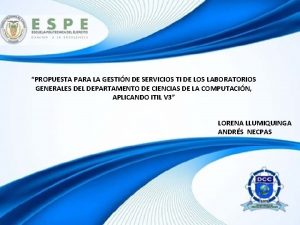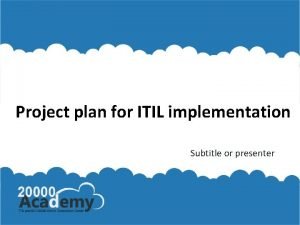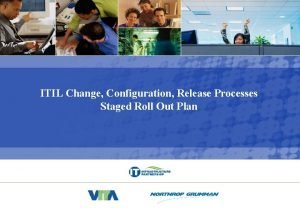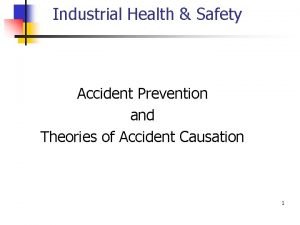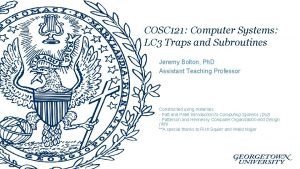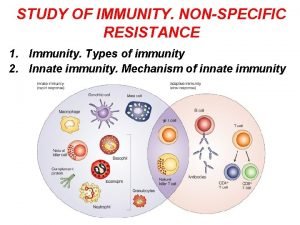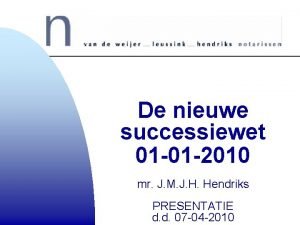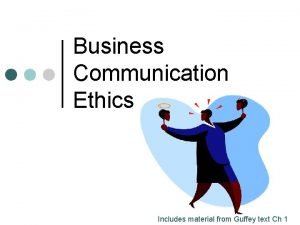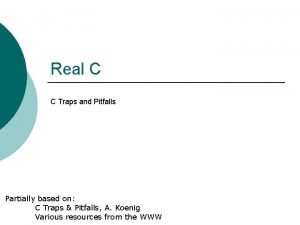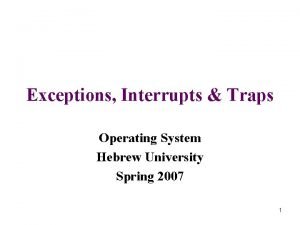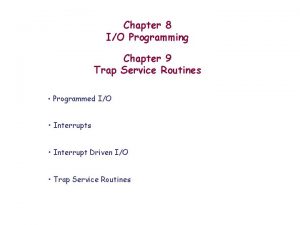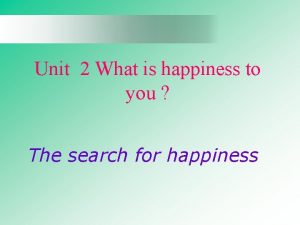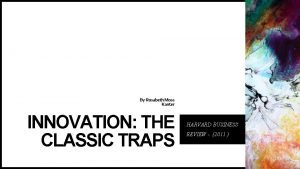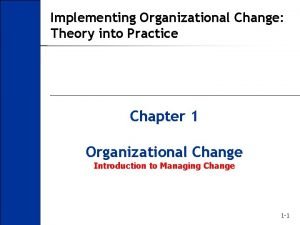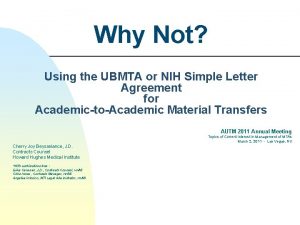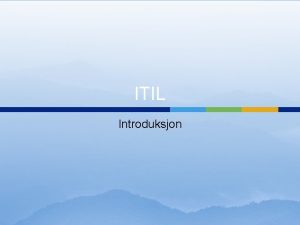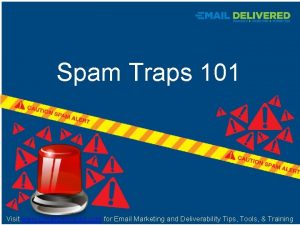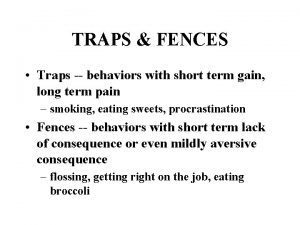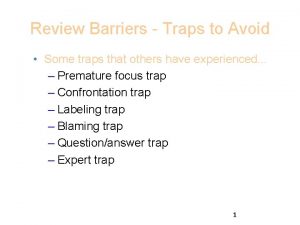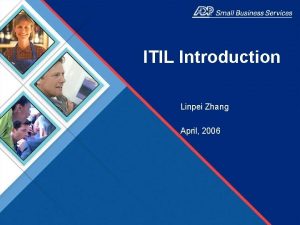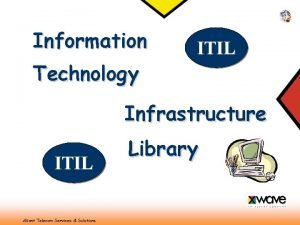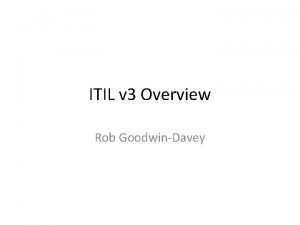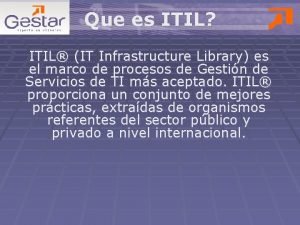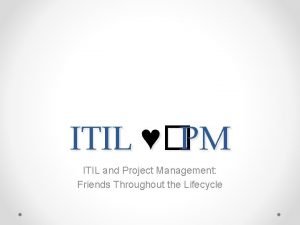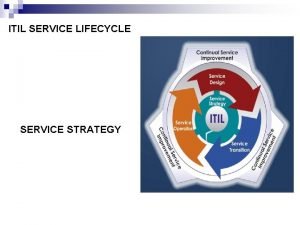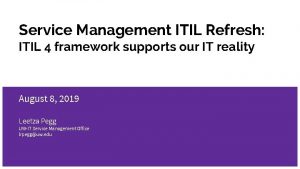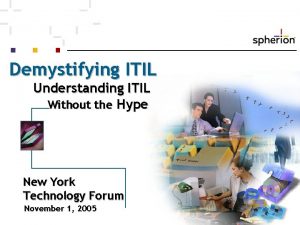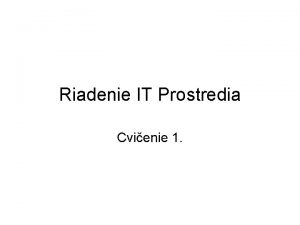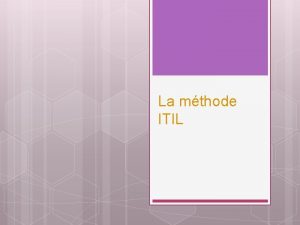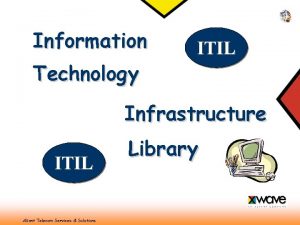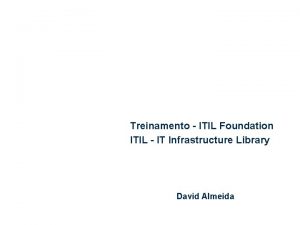9 ITIL IMPLEMENTATION TRAPS IMPLEMENTING ITIL FOR TRANSFORMATION




















































- Slides: 52

9 ITIL IMPLEMENTATION TRAPS IMPLEMENTING ITIL FOR TRANSFORMATION © Cask LLC. All rights reserved. The Cask name and logo are registered trademarks. All content contained in this document is protected by copyright laws, and may not be reproduced, republished, distributed, transmitted, displayed, broadcast or otherwise exploited in any manner without the express prior written permission of Cask.

9 COMMON TRAPS TO AVOID FOR IT TRANSFORMATION IMPLEMENTING ITIL FOR TRANSFORMATION IS AS MUCH ABOUT WHAT TO AVOID AS WHAT TO DO NEXT THE HISTORY OF IMPLEMENTATION PROJECTS IS RIPE WITH EFFORTS THAT GROUND TO A HALT AFTER SEVERAL MONTHS, ENDED UP WITH VASTLY REDUCED SCOPE, OR SIMPLY FAILED TO LIVE UP TO THE EXPECTED BUSINESS 2 © Cask LLC. All rights reserved. Disclosure is subject to the restriction on the title page of this document. BENEFITS

ORGANIZATIONAL CHANGE MANAGEMENT (OCM) IS THE PRACTICE OF LEADING PEOPLE THROUGH CHANGE 3 © Cask LLC. All rights reserved. Disclosure is subject to the restriction on the title page of this document.

TRAP ONE RUNNING AN IMPLEMENTATION PROGRAM AS AN IT PROJECT 4 © Cask LLC. All rights reserved. Disclosure is subject to the restriction on the title page of this document.

CONSEQUENCES… OF RUNNING ANITIL TRANSFORMATION PROGRAM LIKE A PROJECT • Solutions may be rejected by the people they were supposed to benefit because they were not involved. • Resistance to implementing new service improvements may arise. • People revert back to behaviors and ways of working that they feel comfortable with doing. 5 © Cask LLC. All rights reserved. Disclosure is subject to the restriction on the title page of this document.

SOLUTIONS Organizational Change Management is a discipline that addresses these kinds of issues. But it is no small task; the amount of effort to strategize and execute a strong organizational change strategy is typically underestimated. 6 © Cask LLC. All rights reserved. Disclosure is subject to the restriction on the title page of this document.

OCM IS A WORK-STREAM WITHIN A PROGRAM Engagement Management Start. Now Risk, Issue, Decision, Action and Change (RIDAC) Management Iteration Feedback Discover Plan Prepare Cask OCM Cask Process User Stories, Data Requirements, Integration Requirements 7 Current State Analysis Deploy Opera te Transform Product Sprint Backlog Priority Stories Revised Process Mapping KPIs and Metrics Change Definition and Planning © Cask LLC. All rights reserved. Disclosure is subject to the restriction on the title page of this document. Awareness Communication Alignment Communication Gains Communication Engagement Alignment Reinforcement Simulation Training Re-training

CONSIDERATIONS • Implementing processes result in many changes to how perform their work. • New processes require winning the hearts and minds of the people in the organization to adopt and ingrain new techniques and ways of working. • Consider how affected initiatives outside IT will be involved as the implementation effort moves forward. 8 © Cask LLC. All rights reserved. Disclosure is subject to the restriction on the title page of this document.

QUESTIONS TO ASK • How will disparate IT functions and ways of working together be tied together? • If the current IT organization is structured around technology, what changes, organizations and behaviors are needed for Service Management to take root? • How will you deal with organizational factions that may or may not be on board for this effort? • How will others be convinced about the importance of Service Management? • Who are your IT and business stakeholders? • How will you manage your stakeholders? 9 © Cask LLC. All rights reserved. Disclosure is subject to the restriction on the title page of this document.

TRAP TWO IMBALANCE BETWEEN STRATEGIC EFFORTS AND SHORT TERM WINS 10 © Cask LLC. All rights reserved. Disclosure is subject to the restriction on the title page of this document.

THE TRAP –STRATEGIC EFFORTS VS SHORT TERM WINS It is surprising how many times you hear the following statement from IT organizations planning to implement ITIL: We started our ITIL initiative in the first quarter of this year. This will be a major effort for the IT department. We expect that this will be a 2 -3 year effort before we will reap the benefits that ITIL has to offer. 11 © Cask LLC. All rights reserved. Disclosure is subject to the restriction on the title page of this document.

CONSEQUENCES It is likely that implementation projects scoped in this manner will be abandoned for other priorities. Solutions The solution to this problem is balancing short-term gains with the more strategic long-term gains. 12 © Cask LLC. All rights reserved. Disclosure is subject to the restriction on the title page of this document.

CHANGES DIFFER IN MAGNITUDE Incremen tal Change 1 st Order Change 2 nd Order Change 13 © Cask LLC. All rights reserved. Disclosure is subject to the restriction on the title page of this document. Behaviors Attitudes Value s • You can think of the collective frame of reference of your organization as a set of protective layers • The deeper the layer you attempt to impact, the higher the magnitude of, and the more transformational, the change • Transformational changes require more resources, higher skill and more time

CONSIDERATIONS • In today’s business climate, benefits must be shown within a year or less, preferably within the first 6 months. • The trap of short-term gains is to lose sight of the larger ITIL strategic goals. Focus too much on the short-term gains and the larger ITIL strategic benefits may be lost or never realized • The trap of too much focus on the long-term strategic side is that process designs become shelf-ware. • Benefits of short-term gains: ∗ They are usually specific enough that most company staff can relate. ∗ Staff can easily see where the effort is going, which boosts acceptance and cooperation. ∗ The business will see tangible results. ∗ Allows the implementation team to gain immediate wins and earn positive recognition from the business. 14 © Cask LLC. All rights reserved. Disclosure is subject to the restriction on the title page of this document.

QUESTIONS TO ASK • Is there a subset of the larger solution that can be rapidly implemented? • Can just the foundations of the processes be implemented first? • Can short-term solutions rapidly address acute business needs? • Is it possible to target only the top 5 -20% of the solutions that will meet 60 -80% of the need? • Can short-term solutions be linked together within process foundations so as not to lose the overall strategic vision? 15 © Cask LLC. All rights reserved. Disclosure is subject to the restriction on the title page of this document.

TRAP THREE FOCUSING ON SELECTED PROCESSES VS ALL OF SERVICE DELIVERY AND SERVICE SUPPORT 16 © Cask LLC. All rights reserved. Disclosure is subject to the restriction on the title page of this document.

THE TRAP –SELECT PROCESSES VS SERVICE DELIVERY Starting off an ITIL implementation effort by focusing on one or a few selected processes (i. e. “we’re doing only Incident and Problem this year…”). Consequences Half-baked process solutions and rework occurs later in the project when other processes are addressed. 17 © Cask LLC. All rights reserved. Disclosure is subject to the restriction on the title page of this document.

SOLUTIONS By addressing all of the processes simultaneously you will fully implement Service Management instead of just part of it. 18 © Cask LLC. All rights reserved. Disclosure is subject to the restriction on the title page of this document.

CONSIDERATIONS 19 • ITIL processes are interdependent, not standalone entities. ∗ For example: Configuration Management cannot be implemented without Change Management to control changes to the Configuration Database. • The common reasons for parsing processes are concern over the amount of change that can be absorbed at one time and resources availability. • When conducting implementations this way it is found that many of the perceived benefits of the processes are never achieved because teams leave out critical elements • Some process efforts may stall when the team is blocked from proceeding until an output from an unplanned process is in place. • Using workarounds leads to re-work down the road to cure incompatibilities. • It is a mistaken notion that taking on all 10 processes at once means that all ten must be completely implemented as described in the ITIL literature. © Cask LLC. All rights reserved. Disclosure is subject to the restriction on the title page of this document.

TRAP FOUR OVER-ARCHITECTING PROCESS SOLUTIONS 20 © Cask LLC. All rights reserved. Disclosure is subject to the restriction on the title page of this document.

THE TRAP - OF OVER-ARCHITECTING PROCESS Developing every process solution to include deep levels of detail and procedure before solutions are deployed (i. e. the Configuration management Database must contain every hardware/software component, Model number, serial ID, etc. ). 21 © Cask LLC. All rights reserved. Disclosure is subject to the restriction on the title page of this document.

CONSEQUENCES Typical impacts of this trap include: • Costly service improvement projects. • Complex management of the implemented solution. • High risk of failure. • High risk that complexities will result in loss of interest to complete. 22 © Cask LLC. All rights reserved. Disclosure is subject to the restriction on the title page of this document.

SOLUTIONS • Target the 20% of the effort to be taken that will satisfy 80% of the need. • Whenever possible, utilize as much of what may already exists within the organization. • Design something new only when absolutely necessary. 23 © Cask LLC. All rights reserved. Disclosure is subject to the restriction on the title page of this document.

CONSIDERATIONS • Resist the temptation to architect solutions to extreme detail too early. • Be aware that IT people love to reinvent and tinker new solutions and make them as perfect as possible. 24 © Cask LLC. All rights reserved. Disclosure is subject to the restriction on the title page of this document.

QUESTIONS TO ASK • Did every component of hardware, software, network and applications have to be accounted for before anything else could start? • Did you remember the business when architecting solutions? • Are the products the company sells taken into consideration? • Why design your initial solution at the lowest technical level of IT instead of at the top, starting with the company’s customers and services? 25 © Cask LLC. All rights reserved. Disclosure is subject to the restriction on the title page of this document.

TRAP FIVE INAPPROPRIATELY STAFFING THE IMPLEMENTATION EFFORT 26 © Cask LLC. All rights reserved. Disclosure is subject to the restriction on the title page of this document.

THE TRAP - OF POORLY STAFFING TO IMPLEMENT Some organizations have erroneously attempted ITIL implementation efforts by: • Making it a part-time activity for the IT staff. • Populating the effort with IT clerks, analysts or quality assurance staff that have little experience, an ax to grind, or a narrow focus. • Using the ITIL project to further non-project goals. • Staffing the entire effort solely through the IT operations department. 27 © Cask LLC. All rights reserved. Disclosure is subject to the restriction on the title page of this document.

CONSEQUENCES OF STAFFING FAILURES Typical impacts of this trap include: • Service Management projects that never end. • Issues controlling scope and focus. • Significant risk that the overall ITIL effort will stall at deployment time due to unforeseen business issues or requirements. 28 © Cask LLC. All rights reserved. Disclosure is subject to the restriction on the title page of this document.

SOLUTIONS • As the project is staffed, look for both managers and leaders and place them in appropriate roles. • Ensure that all of the business is represented on the project effort to avoid any unforeseen business issues or requirements that were never considered. 29 © Cask LLC. All rights reserved. Disclosure is subject to the restriction on the title page of this document.

CONSIDERATIONS • It is important to understand the difference between a manager and a leader, as both types will be needed. ∗ A manager is someone who has the skills and attention to detail to execute on ideas and tasks to accomplish implementation objectives. ∗ A leader is someone who is willing to challenge the status quo, research new ideas, motivate the project team, break old habits and company boundaries. ∗ The combination of the two properly placed ensures a highly successful project. 30 © Cask LLC. All rights reserved. Disclosure is subject to the restriction on the title page of this document.

QUESTIONS TO ASK • Do you have both managers and leaders in the project? • Are they in appropriate roles? • Is the whole business represented in the program? • Are staff skills adequate? • Are enough resources assigned to the project to be successful? 31 © Cask LLC. All rights reserved. Disclosure is subject to the restriction on the title page of this document.

TRAP SIX TOO MUCH EMPHASIS ON PROCESS MATURITY AS A GOAL OR END STATE 32 © Cask LLC. All rights reserved. Disclosure is subject to the restriction on the title page of this document.

THE TRAP Overselling management on the kinds of benefits they can expect by raising the maturity level of their IT processes. Consequences • Takes the focus off solving real business problems and places it entirely on faith that all those problems will go away once the maturity is raised. • May cause the implementation team to lose track of real business benefits. • May result in extreme upper-management disappointment with the end results of the implementation program. 33 © Cask LLC. All rights reserved. Disclosure is subject to the restriction on the title page of this document.

SOLUTIONS While certainly helpful and important, IT organizations need to be careful that maturity assessments are used as a measure and not an end-deliverable. 34 © Cask LLC. All rights reserved. Disclosure is subject to the restriction on the title page of this document.

CONSIDERATIONS • The main concern is that an implementation effort based on a raised process maturity rating will take the focus away from real business benefit and misplace it on satisfying assessment criteria. • All IT organizations have unique situations, problems and issues. • It might be okay to have below-standard maturity levels in some processes because those processes may not be critical towards meeting business need. 35 © Cask LLC. All rights reserved. Disclosure is subject to the restriction on the title page of this document.

QUESTIONS TO ASK • What are the real business benefits that are to be achieved by increasing maturity? • What does the company gain from more process maturity? • Does every process need to have increased maturity? If not, which processes? • Will higher maturity actually fix our availability problems or reduce incidents and outages? • Maturity assessments serve as important yardsticks towards the more strategic goals and ways of working, not as end-results. 36 © Cask LLC. All rights reserved. Disclosure is subject to the restriction on the title page of this document.

TRAP SEVEN SCOPING IMPLEMENTATION TO ONE PROCESSING LOCATION OR DEPARTMENT WITHOUT CONSIDERING HOW SERVICES ARE SUPPORTED 37 © Cask LLC. All rights reserved. Disclosure is subject to the restriction on the title page of this document.

THE TRAP Scoping ITIL effort to implement at just one processing location. Following this, another location will implement ITIL, then another location and so on. 38 © Cask LLC. All rights reserved. Disclosure is subject to the restriction on the title page of this document.

CONSEQUENCES • The business may demonstrate grave disappointment if overall, services are still be delivered poorly because of an incomplete ITIL implementation. • May cause confusion if other locations or departments implement their own initiatives at the same time. 39 © Cask LLC. All rights reserved. Disclosure is subject to the restriction on the title page of this document.

SOLUTIONS • Ensure that the ITIL best practices are put into place at every location where services are being delivered, at the same time. In a large organization, this means instilling these best practices at all locations at once. • Organize and scope efforts to deploy at many locations at once by treating the effort as an organizational change project and not an IT installation effort. • Using structured stakeholder management and coalition team techniques will deliver results much faster than you might expect. 40 © Cask LLC. All rights reserved. Disclosure is subject to the restriction on the title page of this document.

CONSIDERATIONS • A global organization may have customers, products and services that cross many processing sites and locations. So addressing only one processing location will provide little benefit. • Most IT organizations avoid universal implementation citing concerns over resources and time. • There may be a high level of discomfort with working with other IT organizations from other locations. • Successfully implementing in only one location will not yield the expected business benefits. 41 © Cask LLC. All rights reserved. Disclosure is subject to the restriction on the title page of this document.

TRAP EIGHT TREATING ITIL IMPLEMENTATION AS A ONE-TIME PROJECT 42 © Cask LLC. All rights reserved. Disclosure is subject to the restriction on the title page of this document.

THE TRAP Implementing ITIL solutions as a single project without any consideration for ongoing operation and enhancement. CONSEQUENCES • Service Management improvements will disappear quickly. • Staff behaviors will revert back to pre-Implementation behaviors. 43 © Cask LLC. All rights reserved. Disclosure is subject to the restriction on the title page of this document.

SOLUTIONS • Treat the ITIL Implementation as an ongoing program CONSIDERATIONS • The key concern is ensuring that over time the business gains obtained by the ITIL Implementation will continue and increase. • New process solutions, just like hardware and software, require ongoing maintenance. • Active and continuous efforts are needed to maintain the viability of the solutions with business and IT over time. 44 © Cask LLC. All rights reserved. Disclosure is subject to the restriction on the title page of this document.

CONSIDERATIONS CONTINUED…. • Processes need to be managed on a continual basis to ensure that they are appropriate and in place at all times. • There may also be a need for continual improvement of what was originally put into place. • Additional process enhancements may be needed over time. • Much of this is documented within the main ITIL literature. Yet many companies still approach implementation efforts as if they are a one-time project. • Some companies recognize that processes are always ongoing and evolving, but fail to include how this will take place as part of the original implementation effort. 45 © Cask LLC. All rights reserved. Disclosure is subject to the restriction on the title page of this document.

QUESTIONS TO ASK • Do processes change to meet business needs? 46 © Cask LLC. All rights reserved. Disclosure is subject to the restriction on the title page of this document.

TRAP NINE IMPLEMENTING ITIL WITHOUT AN IMPLEMENTATION GOVERNANCE PROCESS 47 © Cask LLC. All rights reserved. Disclosure is subject to the restriction on the title page of this document.

THE TRAP Failing to plan for and include a governance process throughout the ITIL implementation program. 48 © Cask LLC. All rights reserved. Disclosure is subject to the restriction on the title page of this document.

CONSEQUENCES Typical impacts of this trap include: • ITIL effort quickly spirals out of control. • Constant scope increase. • Misses newly discovered, helpful techniques and technologies. • Finger-pointing over responsibilities for scope change. 49 © Cask LLC. All rights reserved. Disclosure is subject to the restriction on the title page of this document.

SOLUTIONS • ITIL Governance process needs to be part of the implementation effort. • A governance process needs to catch and process appropriately all of the following: ∗ New requirements ∗ Differing ideas ∗ New technologies • Key activities of a successful governance process include: ∗ Handling requests to do process activities differently. ∗ Managing scope of the implementation effort. ∗ Staying abreast of ITIL techniques and technologies. ∗ Effectively managing the decision process for scope changes. 50 © Cask LLC. All rights reserved. Disclosure is subject to the restriction on the title page of this document.

CONSIDERATIONS » » » » 51 • A large scale ITIL implementation affects IT and business organizations and requires a well-planned and a careful organizational change approach. • Participants will have differing solution views, agendas, goals and objectives. • It is likely that the organization will already have a number of service improvement initiatives in progress. • The ever-changing fast pace of technology, competition and business changes. • Company and IT organization structure may also be a moving target. • Unique needs of parts of the organization not previously considered. • ITIL process governance is not a part-time duty for a project manager trying to control scope. • Process governance requires care and attention throughout the entire effort and should be ongoing afterward. • Successful process governance involves many people in various decision and research roles. © Cask LLC. All rights reserved. Disclosure is subject to the restriction on the title page of this document.

THE END 52 © Cask LLC. All rights reserved. Disclosure is subject to the restriction on the title page of this document.
 Https://www.servicetonic.es/itil/introduccion-a-itil-v3/
Https://www.servicetonic.es/itil/introduccion-a-itil-v3/ Itil implementation plan
Itil implementation plan Itil implementation plan ppt
Itil implementation plan ppt Ergonomic traps
Ergonomic traps Lc3 trap
Lc3 trap Motivational interviewing traps
Motivational interviewing traps Neutrophil extracellular traps
Neutrophil extracellular traps Steam trap
Steam trap Vietnam war traps
Vietnam war traps Social facilitation psychology
Social facilitation psychology Traps heat shields the surface from harmful radiation
Traps heat shields the surface from harmful radiation Sediment traps construction
Sediment traps construction 2 traps testament
2 traps testament Oil traps
Oil traps Neutrophil extracellular traps
Neutrophil extracellular traps Plant slide
Plant slide Next generation security platform
Next generation security platform Brand image trap
Brand image trap Teentraps
Teentraps Igoole
Igoole Brand image trap
Brand image trap 5 ethical traps in business communication
5 ethical traps in business communication C traps and pitfalls
C traps and pitfalls Interviewing techniques in nursing
Interviewing techniques in nursing Palo alto traps gartner
Palo alto traps gartner Traps in operating system
Traps in operating system The lc-3 traps are synchronous.
The lc-3 traps are synchronous. Happiness traps
Happiness traps Sediment traps construction
Sediment traps construction Incase traps
Incase traps How to filter crawler traps
How to filter crawler traps Innovation the classic traps
Innovation the classic traps Tripod of pricing
Tripod of pricing Implementing nfpa 1600 national preparedness standard
Implementing nfpa 1600 national preparedness standard Process oriented learning competencies
Process oriented learning competencies Management issues central to strategy implementation
Management issues central to strategy implementation Zpf cisco
Zpf cisco Bert spector
Bert spector Scoring model for project selection
Scoring model for project selection Retail management notes doc
Retail management notes doc Implementing organizational change theory into practice
Implementing organizational change theory into practice Planning and implementing crm projects
Planning and implementing crm projects Implement strategies management issues
Implement strategies management issues Implementing strategies management and operations issues
Implementing strategies management and operations issues Matching structure with strategy
Matching structure with strategy Toyota brand hierarchy
Toyota brand hierarchy Autm ubmta
Autm ubmta Group dynamics examples
Group dynamics examples Implementing strategies marketing finance/accounting
Implementing strategies marketing finance/accounting Chapter 7 strategic management
Chapter 7 strategic management Nivea brand architecture
Nivea brand architecture Designing and implementing brand architecture strategies
Designing and implementing brand architecture strategies Hrd program implementation
Hrd program implementation
